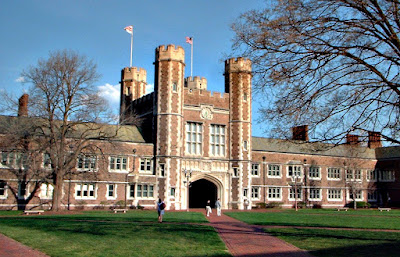Cornell University is a private institution that was founded in 1865. It has a total undergraduate enrollment of 14,453, its setting is rural, and the campus size is 745 acres. It utilizes a semester-based academic calendar. Cornell University's ranking in the 2016 edition of Best Colleges is National Universities, 15. Its tuition and fees are $49,116 (2015-16).
Cornell University, located in Ithaca, New York, has more than 1,000 student organizations on campus, which range from the Big Red Marching Band to the International Affairs Society. First-year students live together on north campus, and the university has housing options for upperclassmen and graduate students, though many choose to live off campus. Cornell has a thriving Greek life, with more than 60 fraternity and sorority chapters. Cornell has more than 30 NCAA Division I varsity teams that compete in the Ivy League. The Cornell Big Red are perhaps best known for their successful men's lacrosse team, which won nine consecutive Ivy League titles from 2003 to 2011. Cornell also has a strong hockey program.Each of Cornell's 14 colleges and schools admits its own students and provides its own faculty, even though every graduate receives a degree from Cornell University. Cornell's two largest undergraduate colleges are the College of Arts and Sciences and the College of Agriculture and Life Sciences. Its graduate schools include the highly ranked S.C. Johnson Graduate School of Management, College of Engineering, Law School and Weill Cornell Medical College. Cornell is also well known for its top-ranked College of Veterinary Medicine and the highly esteemed School of Hotel Administration. One of Cornell's oldest traditions is Dragon Day, during which a dragon built by first-year architecture students is paraded through campus. Notable alumni include U.S. Supreme Court Justice Ruth Bader Ginsburg, author E.B. White and Bill Nye, the "Science Guy."
Cornell University was founded in 1865 as a coeducational, nonsectarian institution where "any person can find instruction in any study." Once dubbed "the first American university" in recognition of the revolutionary principles on which it was founded, Cornell continues to push the limits of its founder's vision. Renowned for its distinctive mix of eminent scholarship, academic rigor and commitment to public service, it attracts more than 20,000 students from every state in the Union and more than 120 countries. They learn from a world-class faculty teaching more than 4,000 courses and participate in cutting-edge research in 11 undergraduate, graduate and professional schools on the uniquely beautiful Ithaca campus, at Cornell's medical college campuses in New York City and Qatar, and in affiliated programs around the world. Cornell's breadth of study, ranging from legendary programs in the humanities to world-class interdisciplinary research centers in nanotechnology, biotechnology, supercomputing and genomics, sets it apart from its Ivy League peers. As the land-grant university of New York State, Cornell also boasts the nation's first colleges devoted to hotel administration, industrial and labor relations, and veterinary medicine. In 2011, Cornell was awarded the opportunity to create a new graduate school for information technology in New York City. Cornell NYC Tech is training the student entrepreneurs who will drive the 21st century???s digital transformation of publishing, advertising, news and information, and entertainment. In recent years, Cornell has been aggressively expanding its international programs - from the establishment, in 2001, of the Weill Cornell Medical College in Qatar, the first American medical school outside of the United States, to the forging of partnerships and collaborations with major institutions in China, India, and Singapore - further supporting Cornell's status as the transnational university of the future.















